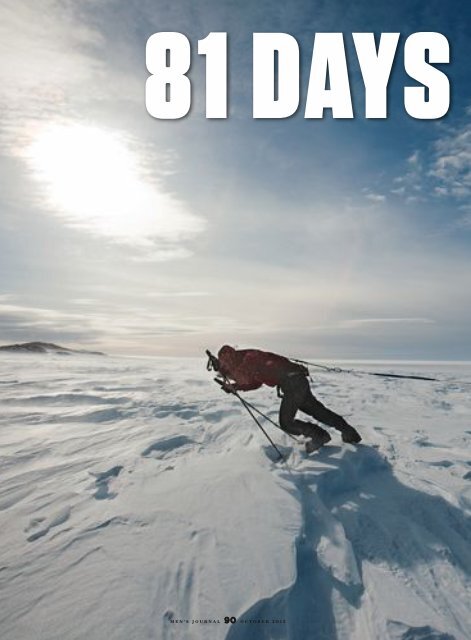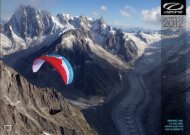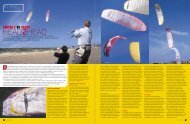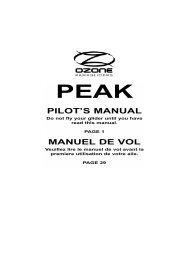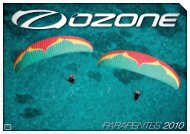81 DAYS ON THE ICE - Ozone
81 DAYS ON THE ICE - Ozone
81 DAYS ON THE ICE - Ozone
Create successful ePaper yourself
Turn your PDF publications into a flip-book with our unique Google optimized e-Paper software.
<strong>81</strong> <strong>DAYS</strong><br />
MEN’S JOURNAL 90 OCTOBER 2012
<strong>ON</strong> <strong>THE</strong> <strong>ICE</strong><br />
Two men embark on an adventure<br />
alone across Antarctica, overcoming<br />
broken ribs, frostbite, and storms<br />
— and setting world records in the<br />
coldest place on Earth.<br />
written and photographed by SEBASTIAN COPELAND<br />
AS YOU STEP OUT onto the<br />
ice sheet, cold air hits you in<br />
the face like a fist of needles.<br />
Nothing quite prepares you<br />
for Antarctica. It is a behemoth.<br />
One and a half times<br />
the size of the United States,<br />
98 percent of its surface is<br />
covered in ice. It is the coldest,<br />
windiest, and driest continent on Earth.<br />
We had arrived at Novolazarevskaya, a<br />
Russian base station on the eastern coast of<br />
Antarctica that services scientific-research<br />
projects, some tourism, and the occasional<br />
expedition, like the one we were about to<br />
begin: a three-month traversal of Antarctica<br />
without assistance and using only land kites<br />
and skis. Transit to “Novo,” which is little<br />
more than a collection of prefab barracks, a<br />
mess tent, and an outhouse, is made aboard<br />
the Russian f lying-cargo workhorse the<br />
Ilyushin-76. The plane’s window-paneled<br />
nose makes it a clear pick out of a lineup,<br />
but inside, the accommodations are strictly<br />
functional. Exposed pipes and ducts are<br />
held together with aging, discolored tape;<br />
passengers and cargo share the same space;<br />
and there are no portholes. No effort has<br />
been made to soundproof the cabin (the<br />
crew distributes ear plugs before takeoff),<br />
and the bathroom is a portable toilet<br />
strapped aft of the plane — literally. Our<br />
six-hour night f light from Cape Town,<br />
South Africa, to the frigid eastern coast of<br />
Antarctica hinted at the spartan life of an<br />
expedition on the ice.<br />
My partner for this trip, Eric McNair-<br />
Landry, has a medium build and a robust<br />
aptitude to endure punishing stretches in<br />
the cold. He grew up in Canada’s northern<br />
territories and, at 26, has a promising future<br />
in the expedition world. An engineer<br />
by training, Eric is happiest far away from<br />
a power grid. Eric and I had trained for
this trip on Greenland. We had spent 42<br />
days crossing its south-north axis, where<br />
we set a new record for the longest distance<br />
traveled with kites over 24 hours, at<br />
370 miles (a journey chronicled in a 2010<br />
article in Men’s Journal). Following two<br />
years of planning, our mission has three<br />
objectives. If successful, we will be the<br />
first to independently reach the Antarctica<br />
Pole of Inaccessibility (POI) — the farthest<br />
point from the continent’s coasts — using<br />
kites and skis. The 1,120-mile stretch from<br />
Novo to the heart of Antarctica makes it<br />
arguably the most remote and diff icult<br />
point of access on the planet. Only five<br />
missions have ever reached the POI — and<br />
only twice since 1964. And all but one<br />
were motorized.<br />
Paul Landry, the famed polar guide (and<br />
Eric’s father), led a team there in 2006, also<br />
using kites. Theirs was a one-way trip,<br />
however, and it also benefitted from air<br />
support. The conditions in Antarctica are<br />
fairly predictable: often windy and always<br />
very, very cold. The danger comes mostly<br />
from human error, failure of equipment,<br />
and overreaching in one’s goals. Even if<br />
you know what to expect, a mistake can<br />
still lead to disaster. Losing a tent while<br />
setting it up in a windstorm is obviously<br />
lethal, but a failed solar panel can also be<br />
critical. On this type of mission, you plan<br />
for the worst and hope for the best, and<br />
when dark thoughts creep into your mind,<br />
you keep them to yourself.<br />
With more than 400 pounds in tow each,<br />
our loads weighed more than double what<br />
Landry’s team pulled, and for us, the POI<br />
would be the first stop of our mission. Our<br />
second objective was to make the first-ever<br />
unassisted and nonmotorized crossing of<br />
the 550 miles separating the POI from the<br />
South Pole, one of the least-known routes<br />
in Antarctica. Third, we would complete<br />
the first-ever east-west transcontinental<br />
crossing of Antarctica via two of its poles,<br />
a distance of more than 2,500<br />
miles. All of this would take<br />
place between November 2011<br />
and February 2012, on the occasion<br />
of the 100th anniversary<br />
of Roald Amundsen and Robert<br />
Falcon Scott’s historic, and<br />
tragic, race to the South Pole.<br />
We had spent two days in<br />
Cape Town meticulously packing<br />
our sledges. We would be<br />
bringing with us two eight-foot<br />
sledges and two four-footers,<br />
as well as four kites of different<br />
sizes. We also had ample stores<br />
of dehydrated food, skis, boots, communications<br />
devices, photo gear — and three pairs<br />
of underwear each. We quickly secured 35<br />
liters of white fuel for our cooking stoves<br />
Sebastian Copeland is an explorer,<br />
photographer, and environmental advocate,<br />
who holds four polar records.<br />
From left:<br />
Copeland,<br />
after almost<br />
three months<br />
of traveling<br />
in Antarctica;<br />
his partner,<br />
McNair-Landry,<br />
pulling a sledge<br />
with more than<br />
400 pounds of<br />
supplies across<br />
the ice by kite<br />
and skis<br />
from Novo’s station manager,<br />
strapped on our skis, clipped<br />
the pulling trace onto our harnesses,<br />
and took our first steps<br />
of the expedition. Or at least<br />
attempted to.<br />
Eric and I are seasoned<br />
adventurers, prepared both<br />
physically and mentally for the challenge of<br />
pulling heavy loads in extreme conditions,<br />
where temperatures can often reach below<br />
–50˚F. But within minutes, our muscles<br />
were gorged with blood, and sweat was<br />
beading all over our bodies. We had started<br />
near sea level, and before we could get the<br />
kites in the air, we would have to ascend<br />
9,500 feet up a glacier and through multiple<br />
crevasse fields to reach a favorable wind<br />
line on the plateau. It seemed incomprehensible<br />
that we would be able to achieve<br />
that. Each irregularity in the terrain was<br />
an opportunity for the sledges to snag and<br />
abruptly bring the effort to a stop. By the<br />
end of the first day, we had covered only one<br />
and a half miles. It took us three days to lose<br />
sight of the station. “Convicts don’t work<br />
this hard,” Eric said on one of our short food<br />
breaks. But we advanced steadily, gaining<br />
ground and elevation amid an arresting<br />
landscape of vertical mountains piercing<br />
skyward through the ice. Slowly, even the<br />
tallest peak was swallowed up by the rising<br />
ice cap, until the last of the mountains<br />
disappeared from sight.<br />
MEN’S JOURNAL 92 OCTOBER 2012
MAP BY HAISAM HUSSEIN<br />
After 15 days of sweating and cursing,<br />
we finally reached the plateau.<br />
On our f irst night, a brutal storm<br />
pinned us down in the tent for three<br />
days.<br />
WHEN A STORM hits in<br />
Antarctica, the tent is<br />
your only chance of survival.<br />
It is like an additional member<br />
of an expedition. In a storm like the<br />
one we experienced, you see displays<br />
of nature’s fierce power. The sky closes<br />
in, visibility drops, the wind kicks up<br />
to 60 mph, and temperatures sink —<br />
in east Antarctica in early November,<br />
temperatures average around –30˚F.<br />
In these conditions, all you can do is build a<br />
snow wall to shield the tent from the wind,<br />
bury yourself deep in your sleeping bag,<br />
and wait for it to pass. With the elements<br />
raging, tent life can be surprisingly tranquil.<br />
A good book, a chess game, or an iPod<br />
can take your mind off the harsh realities<br />
outside. We also spent our time in the tent<br />
recalculating the daily distance scenarios<br />
required to meet our goals and assessing<br />
the likelihood of success.<br />
Other than storms, air movement on an<br />
ice cap is dominated by katabatic winds.<br />
Katabatic, from the Greek word katabatikos,<br />
or “going downhill,” refers to the<br />
movement of air down an ice slope. When<br />
cool air reaches the ice, it gains density.<br />
This heavier air will roll down a grade, if<br />
there is one, governed by the same law that<br />
hit Newton in the head with the apple. The<br />
katabatic process makes wind direction<br />
fairly predictable on an ice cap, and with a<br />
careful choice of route, it favors kite-skiing<br />
expeditions. Unlike in cross-country skiing,<br />
kites help you cover vast areas relatively fast.<br />
Due to its size, remoteness, and the<br />
antagonistic nature of its environment,<br />
Antarctica remains the least explored<br />
Conditions in<br />
Antarctica are fairly<br />
predictable: often<br />
windy and always<br />
cold. Danger comes<br />
from human error,<br />
failed equipment,<br />
and overreaching<br />
in one’s goals.<br />
Larsen<br />
Ice<br />
Shelf<br />
Hercules Inlet<br />
ANTARCTIC CIRCLE<br />
1,000 MILES<br />
Ronne<br />
Ice<br />
Shelf<br />
AMUNDSEN<br />
ROUTE<br />
COPELAND<br />
ROUTE<br />
Ross<br />
Ice Shelf<br />
Novolazarevskaya<br />
Station<br />
South Pole<br />
Pole of<br />
Inaccessibility<br />
ANTARCTICA<br />
SCOTT<br />
ROUTE<br />
landmass in the world. Other than the katabatic<br />
winds, though, the history of Antarctic<br />
expeditions begins and ends with<br />
the sastrugi. Sure, there is the cold, the<br />
wind, and the desolation. But the sastrugi<br />
— ice features of varying size and shape,<br />
sculpted by the powerful winds — define<br />
the landscape. Row upon row of closely<br />
stacked ice ridges make travel intensely<br />
challenging. On a kiting expedition anywhere,<br />
the sastrugi will fray your joints and<br />
rattle your fillings. But in Antarctica, they<br />
will destroy your equipment, your bones,<br />
and sometimes your spirit — pretty much<br />
in that order, as we would soon find out.<br />
This year was especially bad for the sastrugi.<br />
Around the same time as our trip,<br />
two other expeditions had been forced to<br />
stop, and a third had requested an airlift<br />
to a further deployment because of the sastrugi.<br />
It wasn’t long before the tip of my ski<br />
jammed into the head of one, and in a flash,<br />
I received a lesson in physics: The force displaced<br />
while kiting is equal to the mass of<br />
the sledge plus your weight, in addition to<br />
the pull of the kite, which is measured in<br />
speed, or momentum. In this case, when<br />
you stick a ski into the ice, all that force is<br />
Amery<br />
Ice<br />
Shelf<br />
directed underfoot, and under such conditions,<br />
things tend to break. Breakage is part<br />
of all expeditions; how much redundancy<br />
you build into your supplies requires a<br />
delicate balance between tacking on extra<br />
weight and rolling the dice. Experience<br />
helps, but luck also determines whether you<br />
will go on or abort the mission. Screws and<br />
epoxy held my ski together for less than a<br />
day, but by chance, and against the advice of<br />
my young partner, I had brought a replacement,<br />
and we managed to resume the trek.<br />
Skis are not the only thing that can break,<br />
of course — a lesson I learned on day six<br />
of the expedition. For the first stage, I had<br />
chosen to bring two smaller sledges to<br />
spread the weight and separate it in dual<br />
loads if needed. On paper this seemed like<br />
a good idea. In reality, having “the kids” —<br />
our nickname for the smaller sledges — in<br />
tow only complicated matters. Not only<br />
did they increase the chance of snagging a<br />
nose on a bad piece of sastrugi; while<br />
kiting, they doubled the fishtailing<br />
effect, adding drag and pull to the harness<br />
while killing speed. Both sets of<br />
sledges would occasionally nose-plant<br />
violently into ridges, bringing me to a<br />
sudden stop. I would be squeezed by<br />
the harness until my eyes bugged out,<br />
or I’d be slammed sideways onto the<br />
ice. It was on one such occasion that I<br />
heard a sound that still resonates in my<br />
head: a crack coming from my chest,<br />
followed by a sharp, agonizing pain, as<br />
if a knife had been lodged between my<br />
ribs. I attempted to wiggle the harness<br />
and breathed deeply, but there was<br />
no shaking the pain. Everything I did<br />
made it worse. I landed the kite, struggled<br />
to secure the lines, and dropped<br />
to my knees, the pain overtaking my<br />
body with each breath. I stretched my torso<br />
and could feel bony clanking. The signs were<br />
unmistakable: broken ribs.<br />
Just before I departed on this mission,<br />
fate perhaps had me sit down to dinner in<br />
Cape Town with a fellow adventurer, who<br />
shared with me that he had once broken<br />
a rib on an expedition. I asked him what<br />
he had done about it, and he said: “I swallowed<br />
a bunch of painkillers, sucked it up,<br />
and carried on with the trip.” I’ll admit I<br />
was impressed.<br />
I spent 48 hours resting, with two broken<br />
ribs, thinking about my friend “sucking it<br />
up” and contemplating the nature of failure.<br />
Eventually, though, I got up, sewed leg<br />
straps to the harness, swallowed a mouthful<br />
of Ibuprofen, and hit the trail. This was day<br />
eight. Eighty more to go.<br />
Kiting over long distances is like running<br />
a marathon: You hope for a consistent pace.<br />
But changing conditions can shift the narrative.<br />
On a timeline, with limited supplies,<br />
this can be tense. As we gained elevation, the<br />
cooling temperatures and thinning oxygen<br />
took their toll. Eric developed altitude cough,<br />
and we were both sucking air just buckling<br />
our boots. But it was the light and unstable<br />
OCTOBER 2012 93<br />
MEN’S JOURNAL
winds that increasingly wreaked havoc on<br />
our nerves. The POI is located at 12,220 feet,<br />
one of the highest plateaus in Antarctica.<br />
Katabatic winds accelerate downhill, which<br />
theoretically means the closer you get to the<br />
top — and to our destination — the weaker<br />
the wind. Over the 53 days we spent on<br />
our approach to the POI, we experienced<br />
two kinds of air movement: a few hours<br />
of weak winds, with days of single-digit<br />
miles traveled; and powerful storms that<br />
pinned us in the tent. We attempted to take<br />
advantage of the head or tail of the storms,<br />
which made for white-knuckle kite rides<br />
into virtual whiteouts. But we continued to<br />
progress, mile by mile. And while my ribs<br />
slowly and painfully healed in spite of the<br />
daily squeeze of the harness, a new, more<br />
serious challenge arose.<br />
AFROSTBITE STARTS out looking<br />
like a blister. The body secretes liquid<br />
to protect the next layer of skin.<br />
When that liquid is further exposed to frost,<br />
it sinks down, killing the next layer of skin.<br />
The dead skin hardens and goes necrotic,<br />
turning black, and careful monitoring is<br />
required to prevent it from spreading. If<br />
frost reaches the bone, or the first<br />
knuckle of a digit, amputation is<br />
VITAL<br />
STATISTICS<br />
Total days<br />
on the ice:<br />
<strong>81</strong><br />
Distance<br />
covered:<br />
2,395 miles<br />
Highest point<br />
reached:<br />
12,220 feet<br />
Total elevation<br />
gained:<br />
11,886 feet<br />
Longest<br />
distance<br />
traveled in<br />
a day:<br />
145 miles<br />
Shortest:<br />
960 feet<br />
Sledge weight<br />
at the start of<br />
the trip:<br />
420 pounds<br />
At the end:<br />
150 pounds<br />
Coldest<br />
temperature<br />
without wind<br />
chill:<br />
–40°F<br />
With wind<br />
chill:<br />
–76°F<br />
generally required to prevent the<br />
spread of gangrene.<br />
The Dynafit backcountry boots<br />
I chose for the expedition had been<br />
vetted during our 1,430-mile, 42-<br />
day kite-and-ski journey in Greenland.<br />
Their thin shell offered an excellent<br />
weight-to-strength ratio, but<br />
I paid for it with less warmth than<br />
a traditional boot. For that reason,<br />
I wore a custom overboot made<br />
of synthetic fiberfill and wind-resistant<br />
material. The boots were on<br />
the cool side but remained acceptable<br />
in the frigid Antarctic conditions.<br />
Where I rolled the dice was<br />
on the size: I received the largest<br />
one manufactured by the company,<br />
which, while fitting my size-12 foot<br />
perfectly, did not afford the extra<br />
room that, in cold conditions, allows<br />
air to circulate. With two<br />
pairs of socks, the fit was snug. I<br />
also failed to account for the furious<br />
assault on my feet by sastrugi,<br />
specifically on my big toes. After<br />
two weeks of kiting, my right toe<br />
displayed signs of trauma, and the<br />
nail began turning black. Soon, the<br />
base of the nail was swelling and got<br />
infected. Liquid secreted below the<br />
skin, under the nail, and eventually,<br />
exposed to frigid temperatures, the<br />
liquid caused a cold injury. At the end of<br />
each day, I would anxiously inspect my toe,<br />
only to discover more of the ominous black.<br />
The history of polar exploration is replete<br />
with stubby toes and missing digits.<br />
Strange things happen to the brain on the<br />
ice: The drive to reach a goal can blur rational<br />
thinking. I had no desire to lose<br />
a toe, but there was no way I would<br />
abort my mission to save one, either.<br />
Eric had opted for an Everest<br />
mountaineering boot, which, while<br />
offering little ankle support, delivered<br />
ample warmth. The POI was<br />
217 miles away; we were 900 miles<br />
and 40 days into our journey and<br />
close to accomplishing our first objective.<br />
I decided to press on. Eric<br />
and I traded right boots.<br />
<strong>ON</strong> <strong>THE</strong> 53RD day of the expedition,<br />
we were finally<br />
within striking distance of<br />
the POI. A storm that had pinned<br />
us down for two days was dying.<br />
With good conditions, we could<br />
close the 60-mile gap in four, maybe<br />
five hours. But as we got ready that<br />
morning, the winds continued to<br />
decrease. An hour into the day, our<br />
speed was faltering, as were our<br />
hopes of reaching the POI.<br />
By 2 pm, with barely any wind,<br />
we were struggling to keep the kites<br />
in the air. By 6:30 pm, we had been<br />
on the trail for 10 hours — our longest<br />
stretch of the trip — and a little<br />
more than nine miles remained.<br />
But the wind picked up, and as we<br />
raced over the ice, I scanned the<br />
empty vastness, expecting at any<br />
moment to see a marker on the horizon.<br />
With about four miles to go, we set down to<br />
check our bearings. Good thing: We were<br />
45 degrees off and had nearly overshot our<br />
target.<br />
We lifted off one last time, and within<br />
minutes, I saw that two markers were ahead<br />
of us: the first man-made features Eric and<br />
I had seen since leaving Novo. We sped<br />
toward them. The rough terrain no longer<br />
mattered, the burn in my legs was forgotten,<br />
and the adrenaline even warmed my<br />
toes. Soon, I could make out a derelict communications<br />
tower and the remains of a<br />
drilling platform — relics of a Soviet-built<br />
station at the POI that had been abandoned<br />
more than 50 years ago. A bust of Lenin<br />
propped atop a chimney is all that remains<br />
of the station. Sticking out of the ice, it faces<br />
Moscow: stoic, incongruous, and forlorn in<br />
this desolate space, like a Napoleon exiled<br />
on a frozen Elba. The rest of the base was<br />
somewhere below our skis. Past the tower,<br />
we made a slow downwind turn and landed<br />
our kites. Fifty-three days, 11 hours, and<br />
12 minutes, and we were there. We had<br />
reached the POI.<br />
IN JUNE 1910, a young British naval<br />
off icer named Robert Falcon Scott<br />
set sail for the Ross Ice Shelf in Antarctica<br />
with the ambition of planting the<br />
Union Jack at the South Pole. At about the<br />
same time, the Norwegian explorer Roald<br />
Amundsen began his own expedition to the<br />
Arctic, sailing from Norway with his provisions<br />
and dogs. Once out to sea, Amundsen<br />
changed course and headed for the Ross<br />
Ice Shelf. With Scott and Amundsen both<br />
heading for the South Pole at the same<br />
time, the greatest race in polar history<br />
had begun.<br />
Amundsen’s sharp tactical thinking and<br />
experience in the Arctic made him a fiercely<br />
efficient leader. He knew the proper clothing<br />
for the environment and how to use dogs,<br />
which allowed him to successfully reach the<br />
plateau from the Axel Heiberg Glacier and<br />
MEN’S JOURNAL 94 OCTOBER 2012
set up supply caches along the way.<br />
On December 14, 1911, Amundsen<br />
and his team were the first to reach<br />
the South Pole.<br />
Scott, meanwhile, was using<br />
tractors and ponies, not dogs. The<br />
tractors proved useless in the deep snow of<br />
the Ross Ice Shelf, and all the ponies died.<br />
Scott and his four-man team reached the<br />
pole on January 17, 1912, but their dream of<br />
planting the British flag was thwarted by<br />
the sight of a tent flying Norwegian colors.<br />
Inside was a note left by Amundsen, addressed<br />
to Scott:<br />
Dear Captain Scott — As you probably<br />
are the first to reach this area after us, I<br />
will ask you to kindly forward this letter<br />
to [Norwegian] King Haakon VII. If you<br />
can use any of the articles left in the tent,<br />
please do not hesitate to do so. The sledge<br />
left outside may be of use to you. With<br />
kind regards I wish you a safe return.<br />
yours truly,<br />
Roald Amundsen<br />
Scott and his team began their return<br />
journey, but after multiple vicious storms,<br />
they died tragically of cold and starvation a<br />
mere 11 miles from their next<br />
food cache. In the expedition<br />
world, the rivalry between<br />
Norway and England lives<br />
on to this day.<br />
With this in mind, we set<br />
out to cover the 550-mile<br />
stretch that separates the<br />
POI from the South Pole.<br />
This route had been traveled<br />
only once, over two seasons,<br />
by motorized tractors. We<br />
studied wind models, and<br />
conditions on this section<br />
promised to be very light.<br />
But we were 12 days behind,<br />
and weak winds could<br />
threaten our timeline and<br />
the remainder of the expedition.<br />
So when blowing snow<br />
hit the tent on the morning<br />
after our arrival at the POI,<br />
we were quick to break camp<br />
and shoot out of there. The<br />
idea was to drop in elevation<br />
as fast as we could and fall<br />
into a favorable wind setup.<br />
What we got on that crossing<br />
was some of the best wind<br />
of the entire trip, along with<br />
smooth terrain and warming<br />
temperatures. Not that<br />
everything was easy. There<br />
was a leaking fuel canister<br />
that contaminated some<br />
food, three days of dead calm<br />
in the tent, and the accidental<br />
loss of my sleeping bag<br />
during travel. But overall<br />
it went well, and our daily<br />
average exceeded 60 miles<br />
per day.<br />
On January 8, after 1,680<br />
miles of travel, the Amundsen-Scott<br />
South Pole Station<br />
appeared on the horizon.<br />
We had not seen a sign of<br />
( recent) human activity in<br />
65 days, and the sight of a community raised<br />
our spirits. I landed my kite, took in the<br />
sight of the buildings rising from the ice,<br />
and smiled. We were about to complete the<br />
second phase of our mission and reach, 100<br />
years after the fact, the spot where Amundsen<br />
and Scott had made history. I lifted my<br />
kite again and headed for the station.<br />
From left:<br />
Copeland and<br />
McNair-Landry<br />
celebrate by the<br />
bust of Lenin<br />
at the Pole of<br />
Inaccessibility;<br />
Copeland’s<br />
frostbitten toe;<br />
McNair-Landry,<br />
son of a famed<br />
polar guide, on<br />
the opening leg<br />
of the journey<br />
We met other adventurers who had skied<br />
here from other points to commemorate the<br />
centennial. We recognized the weary look<br />
of struggles on the ice. When you reach the<br />
bottom of the Earth, the stories of those who<br />
have, too, become part of your own, and<br />
instant friendships are born. But where their<br />
trip had ended (they would all be leaving<br />
the station by plane), we had another 745<br />
miles still to go. After two rest days waiting<br />
for wind, the familiar flapping of the tent’s<br />
wall beckoned to us. The wind was building.<br />
Our time was up.<br />
We had monitored the conditions all day,<br />
and while the forecast had called for light<br />
winds, it was now blowing snow, reaching<br />
18 knots and building. Eric and I had<br />
psyched ourselves to leave; the social life<br />
at the base was like a siren luring us to<br />
stay and challenging our resolve. We were<br />
ready to leave — we were dressed for the<br />
trail, the tent had been packed, the sledges<br />
rearranged, and the kites were laid out on<br />
the ice, gently bouncing in the gusts. The<br />
visibility had dropped to about a mile, which<br />
was just enough to make out the perimeter<br />
of the station, but not more. Our new friends<br />
were waiting in the cold to bid us farewell.<br />
Their faces displayed a mix of curiosity with<br />
the incredulous disconnect that comes from<br />
knowing that your mission has ended while<br />
witnessing the familiar steps of others committing<br />
to another round. It is a blend of<br />
relief and envy.<br />
Eric and I walked to our lines, clipped in,<br />
raised our kites in the air, and glided away<br />
from the camp. We followed a flagged route<br />
that cut right through the station and then<br />
out. The gap between the markers grew, and<br />
as the visibility dropped, they quickly faded<br />
from view. At the last f lag, I looked back.<br />
The station had disappeared, shrouded in<br />
a cloak of white. The kites were diving up<br />
and down, our skis were scratching the ice<br />
below us, and our speed was growing. We<br />
were back on the trail.<br />
IT TOOK 12 <strong>DAYS</strong> to reach the western<br />
coast of Antarctica. When the<br />
kites came down for their final landing,<br />
there were no parades, no podium or<br />
cash prizes, no cheering crowds or laurel<br />
wreaths. But we had our limbs, our wits,<br />
all of our toes (minus a few millimeters for<br />
some), and memories for a lifetime. We had<br />
also laid claim to three new polar records,<br />
and our names would forever be etched in<br />
the history of Antarctica firsts. In Antarctica,<br />
beauty is everywhere. With its endless<br />
white canvas, it asks many questions about<br />
the reality that you choose, pushing you to<br />
go where you never knew you could. The<br />
great climber Voytek Kurtyka once said:<br />
“Alpinism is the art of suffering.” This is also<br />
true of polar travel. When doubts arise, you<br />
would be well served to remember the two<br />
laws of perseverance. First: Put one foot in<br />
front of the other. Second: Keep walking.<br />
If you have trouble with the second, refer<br />
back to the first. <br />
OCTOBER 2012 95<br />
MEN’S JOURNAL


